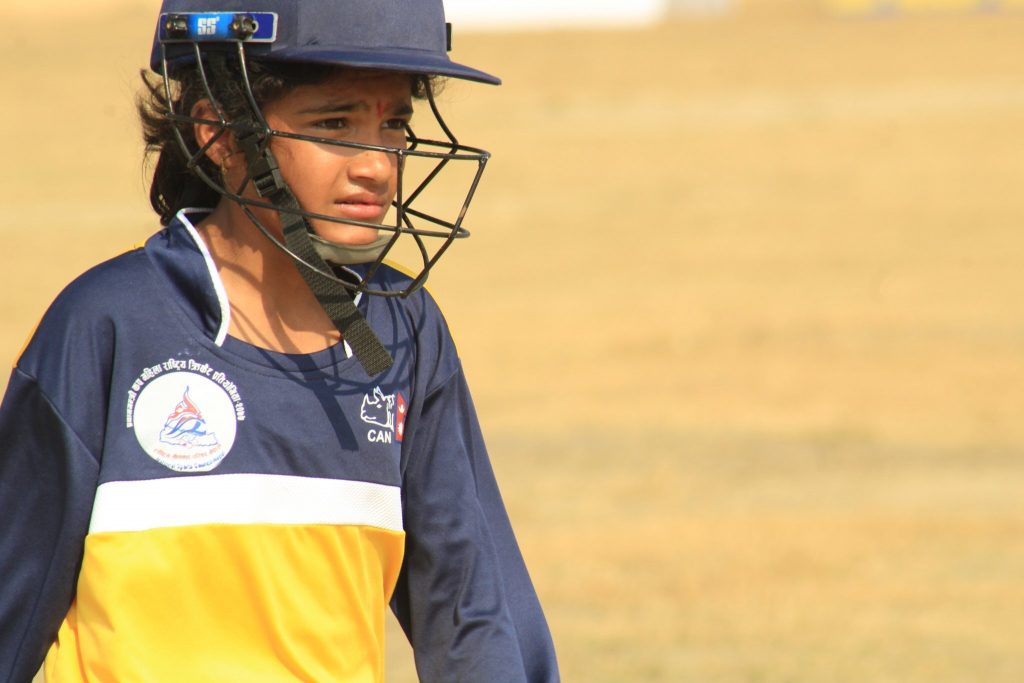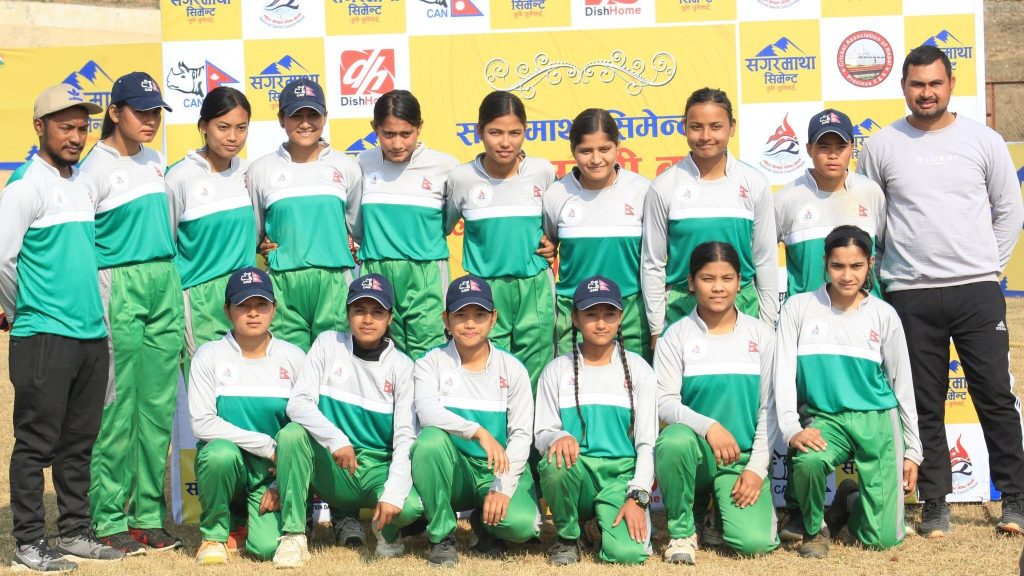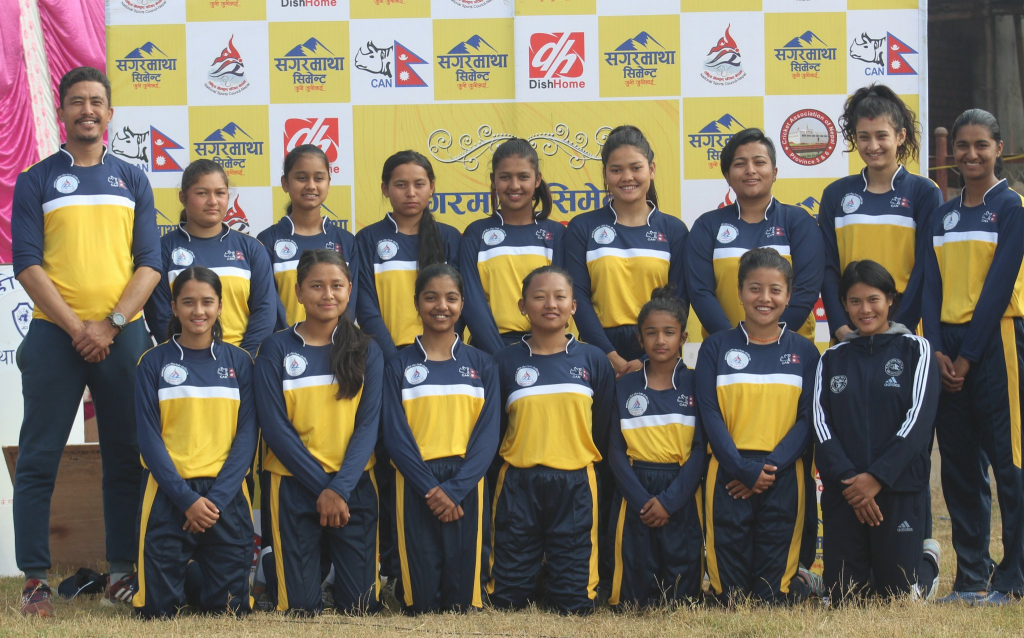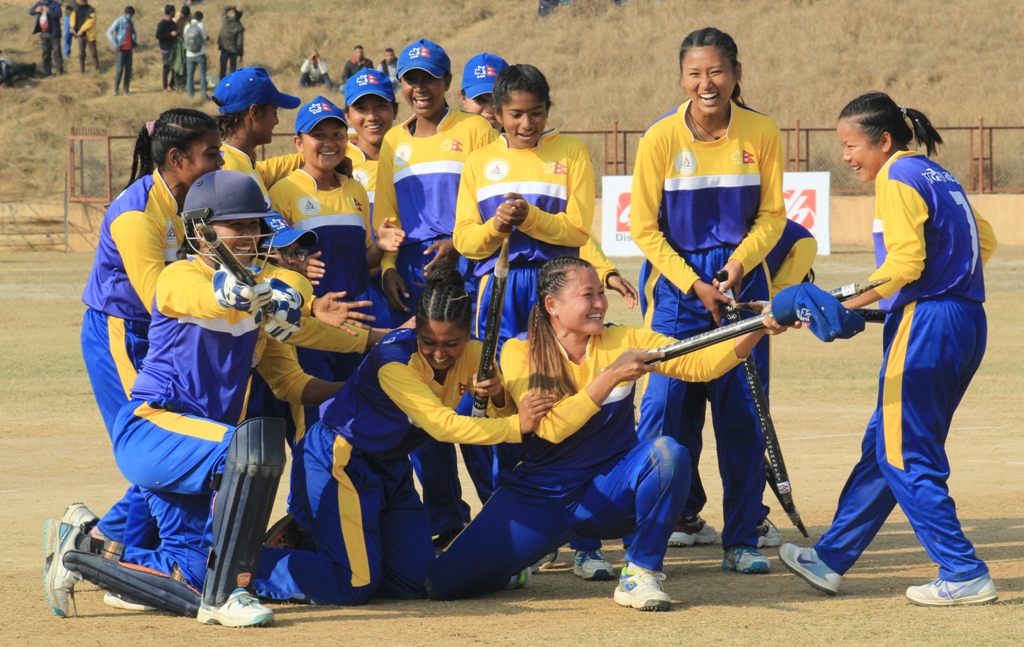The recent PM Cup Women’s National Cricket tournament is a positive development for women’s cricket in Nepal. ‘Province Number One’ beat defending champions Armed Police Force (APF), incidentally the only government department team, by six runs to clinch the title, ending the latter’s four year winning streak in national women’s cricket tournaments.
The final of the PM Cup Women’s National Cricket Tournament saw the highest number of attendees at a women’s cricket match in Nepal’s history. This is important because the tournament was held in Dang, far away from Kathmandu.
Cricket Association of Nepal’s (CAN) flagship women’s tournament saw the participation of 12-year-old Jyotsnika Marasini from Gandaki Province, making her the youngest cricketer participating in the tournament. Nepal international 38-year-old, Ritu Kanaujia (aged 38) from Sudur Paschim province brought all her experience to bear, hopefully inspiring many a young player at the tournament in the process.
Nearly 400 girl cricketers participated in various district and provincial selection games. From there, more than a hundred cricketers were selected to represent the eight teams – seven Provinces and the APF – in the tournament.

On-field disparities
There were significant disparities in the level of skill and experience on display during the tournament. The victory margins were generally so large that only the final was particularly competitive.
A key reason for the disparity in the standards is that local administrative bodies are not being able to carry the popularity of the game to the community level. Outside of the national tournament window, there are no professional setups in most of the local areas to train, groom, and nourish budding cricketers. As a result, a number of teams were forced to pick young, amateur players, with little experience at the national level.

By contrast, APF is star-studded with the national cricketers, largely because it is able to pay players and guarantee a degree of financial stability for them. On the other hand, the provincial sides build their sides in a limited time span, and have a limited pool of players to choose from.
If the Association’s provincial bodies had the resources and expertise to establish professional setups and guarantee some financial stability to the local cricketers, more cricketers would take up the game resulting in a larger pool of players at the community level. More number of tournaments at the local level ahead of the national tournament would result in competitive matches at that level.
The message of the minnows: Karnali Province and Gandaki Province
Karnali Province was arguably the weakest side in the tournament, not managing a single victory throughout. Karnali scored a total of just 87 runs in three matches including 33 extras. While bowling, they conceded 124 runs from extras alone.
Karnali is the largest province of Nepal in terms of area, but is also the least populated and developed of the seven provinces participating. Karnali includes some of the most remote areas in the country, completely isolated (no road links) from the nation’s capital.
Sports teams are the representations of our societies. While there are facilities and infrastructures for proper cricket training in major cities of Nepal, these are scarce in Karnali province. One reason among many behind Karnali’s below-par performance in the tournament is the province’s overall socio-economic situation. It is amongst the poorest in the country, and in this context, putting forward a team is, in and of itself an achievement.

When Emerging Cricket spoke to the coach of the Karnali Province, he said ‘the cricketers are very young and inexperienced. Most of them are school students from Dailekh, Salyan, and Surkhet who are very passionate about the game. We could only manage to carry out two days of camp for the preparation of the tournament. They met the national cricketers at the tournament who they looked up to and exchanged experiences with them. Despite heavy losses, we have returned back positively as the girls are very excited and are willing to continue [playing] the game.’
Similarly, Gandaki Province scored only 143 runs in the entire tournament. Playing against Province One, they were all out for seven runs with nine of their batters failing to get off the mark. Similar to Karnali province, most of the players are school students who are new to the game. Five of their cricketers Seemana KC (vc), Purnata Shahi, Anjali Bishwokarma, Soniya Thapa, and Kusum Godar study in the same school in Syangja and are learning cricket at the W-13 cricket club.
When the team Gandaki played against Sudur Paschim Province in their second match of the tournament, their school in Syangja District projected the match live on the big screen in order to get other young students interested.
Gandaki Province captain, Shila Regmi Chhetri, was a handball player two years ago and wanted to become an army officer. Later, she started pursuing a cricket career and despite various hurdles, represented Nepal’s U-19 team in China last year. 12-year old Marasini was not even born when the Nepal Women’s Cricket team made their international debut at the ACC Women’s Tournament 2007. Jyotsnika and Amrita Wagle are learning their craft at the Syangja Cricket Club.

The message from the minnows: “We want to learn and improve. We need proper care and guidance from every stakeholder.”
Women’s cricket ‘just exists’
The attitude of Nepal’s cricket administrative body towards women’s cricket is a major obstacle to it’s progress. After 13 years of international competition, the Nepal women’s cricket team is treated as ‘just existing.’ In practice, there exist massive disparities in salaries, tournament standards, venues, training facilities, coaching staff, sponsorships, and prize money allocated to men’s and women’s cricketers.
The format of the PM Cup reinforces this conclusion. The national tournament was played in a T20 format and ran for eight straight days with only a rest day before the semi-final. No considerations were given to players’ rest and recovery in this format.
The tournament saw two matches each day, played one after the other at the same venue. Had the tournament been played over a longer period, cricketers who travelled long distances to participate in this rare competition could at least play complete matches.
Four matches of the national tournament had to be shortened due to heavy fog. Two matches were reduced to 16 overs each, one match was reduced to 13 overs and one to 11 overs a-side. But who cared? The presence of a tournament, regardless of its format or conditions of play, was good enough, it seems.
The difference in the standard of venue for men’s and women’s national tournaments is another part of the story.

Although the women’s national team has been recently awarded the central contracts by the Association after 13 years, the wage disparity between the men’s and women’s teams is an issue that no cricket governing officials appear to be interested in tackling now. Of note is the fact that the national football governing body, the All Nepal Football Association (ANFA) has recently announced equal pay to both men and women footballers.
Concluding on a lighter note
Despite these challenges, there is much to be hopeful about from the PM Cup’s Women’s National Cricket Tournament. It’s high time Nepal invested in its Women’s Cricket Team not just for the sake of sport but also as a driving force against inequality in society.
In a country where the President is a woman, women in sport – including from poorer provinces such as Karnali and Gandaki – can be great ambassadors in the fight against gender-based inequality and violence. Some people might think it just needs time, but leaders and decision-makers should be proactive. CAN can be an example to entire Associate cricket world and beyond in this regard.
On the field, with the pathway to ICC Women’s T20 World Cup 2023 announced, it will be about winning those close games to get through to the global stage. Teams like Thailand have already shown that if you invest in women’s cricket in the right way, you will reap rich rewards. It is high time Nepal invests in unleashing women cricket’s true potential.
You’re reading Emerging Cricket — brought to you by a passionate group of volunteers with a vision for cricket to be a truly global sport, and a mission to inspire passion to grow the game.
Be sure to check out our homepage for all the latest news, please subscribe for regular updates, and follow EC on Twitter, Facebook, LinkedIn and YouTube.
Don’t know where to start? Check out our features list, country profiles, and subscribe to our podcast.
Support us from US$2 a month — and get exclusive benefits, by becoming an EC Patron.






